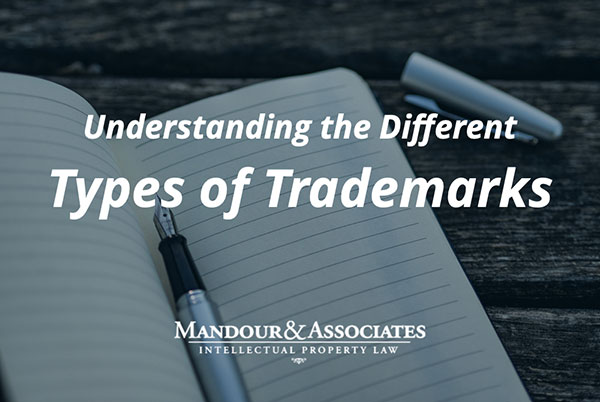Types of Trademarks
 It is thought that there are only three or four different types of trademarks. However, there are many types of trademarks that may receive protection under the Lanham Act.
It is thought that there are only three or four different types of trademarks. However, there are many types of trademarks that may receive protection under the Lanham Act.
Trademarks‚ service marks‚ trade names‚ trade dress, collective marks‚ and certification marks all fall under the broad heading of trademarks. Also, each type of trademark can be considered fanciful, arbitrary or suggestive on the stronger side, and descriptive and generic on the weak side. For information about registering a trademark, you may see our trademark registration page.
Different Types of Trademarks
Types of trademarks include:
- Trademarks;
- Service marks;
- Strong trademarks;
-
- Fanciful Trademarks;
- Arbitrary Trademarks;
- Suggestive Trademarks;
- Weak trademarks;
-
- Descriptive Trademarks;
- Merely Descriptive Trademarks;
- Generic Trademarks;
- Trade names;
- Trade Dress;
- Collective marks; and
- Certification marks.
Trademarks
A trademark is a word‚ name‚ phrase‚ logo‚ or symbol used to identify the source of products or services and distinguish those products from others. It is highly recommended that a trademark be registered, but trademark rights can also be acquired by common law. For more information on registering a trademark, see our trademark registration page.
Famous Trademarks: Some famous trademark examples are: Amazon, Apple, Facebook, Google, and Tesla.
Service Marks
Whereas trademarks identify the source of goods‚ service marks denote the source of services. A business may utilize a service mark to refer to any commercial service from pet grooming to legal representation. A well-known example of a service mark is “Geek Squad‚” which identifies a national computer repair and troubleshooting company. Though service marks are technically distinct from trademarks‚ they receive the same protection and have similar requirements for registration. To achieve trademark status‚ rather than placing products bearing the trademark into the stream of commerce‚ the trademark holder must offer services‚ using the service mark as an identifier‚ to be able to obtain protection. Please see our service mark page for more information.
Strong Trademarks – Fanciful, Arbitrary, and Suggestive Trademarks
Fanciful, arbitrary and suggestive trademarks are the strongest types of trademarks and are entitled to the most protection. Please see our fanciful, arbitrary or suggestive pages for more information.
Weak Trademarks – Merely Descriptive, Descriptive, and Generic Trademarks
Descriptive, merely descriptive, and generic trademarks are considered weak or not protectible. Please see our and descriptive and generic pages for more information.
Trade Name
Rather than identifying a certain product or service‚ a trade name is designed to identify the company as a whole. A corporation or business adopts a specific trade name by using such a name to identify their business‚ perhaps by filing a “Doing Business As” (DBA) form or incorporating within their jurisdiction. A company may have a particular trade name and manufacture a variety of products each bearing different trademarks. For example‚ “Proctor & Gamble” is the trade name of a large company that holds many trademarks including Oral-B. “Church & Dwight” serves as a trade name for the company that produces products bearing the Arm & Hammer trademark. Generally trademark applications should be filed for trade names just as they should for trademarks.
Trade Dress
Trade Dress is the overall design‚ appearance‚ and aesthetic attributes of a product’s packaging. While functional designs are covered under patent law‚ to receive trade dress protection‚ the design must be non-functional and purely aesthetic. Trade dress can encompass a variety of designs from the packaging or wrapping of food items to the interior and exterior design of restaurants. In order to obtain protection‚ trade dress requires secondary meaning. For more information, you may see our trade dress page.
Collective Marks
A collective mark is a trademark used to indicate membership in an organization‚ association‚ or union. For example‚ the collective mark CPA indicates the Society of Certified Public Accountants and their members. A certified public accountant can use the CPA mark to express to others that she is a member of this society and is therefore qualified as an accountant. In addition‚ an accountant can distinguish his services from one who has not qualified for membership in the Society of Certified Public Accountants.
Certification Marks
A certification mark is a word or symbol that indicates that a product or service has been approved by or meets the standards or qualifications of a certifying organization or association. A certification mark may be issued by an organization to indicate geographical origin‚ quality‚ type or process of manufacture‚ or other attributes. Examples of certification marks include Washington Apples‚ Certified Organic‚ Fair Trade‚ and the Cotton logo.
Featured Client Review
“Great service and affordable prices. Very knowledgeable and a pleasure to work with.” – Gregory M. ★★★★★
Contact Us
If you are interested in registering a trademark, please feel free to contact us.













